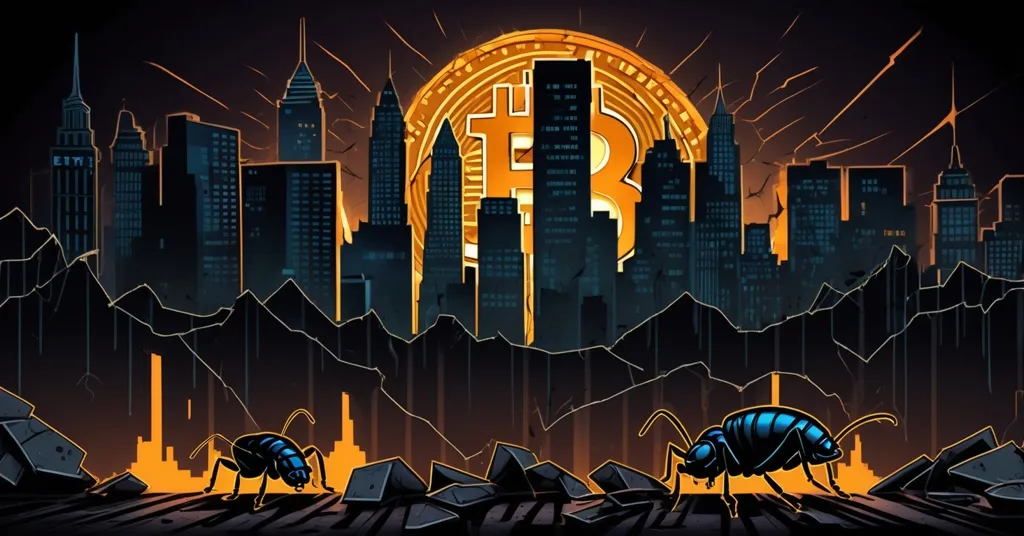Jamie Dimon’s ‘Cockroach’ Warning: Hidden US Economic Risks and Bitcoin’s Potential Fix

Jamie Dimon’s ‘Cockroach’ Warning: Hidden Threats in the US Economy and Bitcoin’s Potential Role
Jamie Dimon, the straight-shooting CEO of JPMorgan Chase, has sent a shiver down Wall Street’s spine with a brutal analogy about the state of the US economy. Likening hidden financial threats to “cockroaches,” he’s hinting that spotting one problem means there’s likely a nest of others waiting to crawl out—a warning that hits hard in both traditional finance and the crypto world.
- Dimon’s Red Flag: Hidden “cockroaches” signal deeper systemic risks in the US economy.
- Bankruptcy Fallout: Tricolor Holdings and First Brands collapses hammer banks with major losses.
- Crypto Connection: Financial instability underscores Bitcoin’s appeal, despite its own flaws.
Dimon’s Grim Metaphor: Unseen Pests in Finance
During a recent earnings call, Dimon didn’t mince words when addressing the fragility of the current financial system. His pointed remark, as reported in a detailed piece on Dimon’s stark economic warning, sliced through the usual corporate spin:
“I shouldn’t say this, but when you see one cockroach, there’s probably more. Everyone should be forewarned on this one.”
This isn’t just a colorful quip—it’s a dire heads-up rooted in real, messy problems. The bankruptcies of Tricolor Holdings, a subprime auto lender, and First Brands, an auto parts supplier, in September have exposed cracks in the system. For those new to the term, subprime auto lending involves loans to borrowers with poor credit scores for car purchases—high-risk deals that often sour when the economy tightens. These failures aren’t mere blips; they’ve triggered a cascade of losses across mid-sized banks and investment firms, raising fears of broader instability.
Zions Bancorporation felt the sting with a 13% stock plunge after a $50 million charge-off—basically, writing off uncollectible loans as a direct hit to profits—through its California Bank & Trust division. Western Alliance wasn’t far behind, with its stock dropping nearly 10% after filing a fraud lawsuit over a credit facility tied to Cantor Group V LLC. Even a titan like JPMorgan wasn’t immune, taking a $170 million charge-off linked to wholesale lending to Tricolor. Dimon admitted the misstep with uncharacteristic humility:
“It was not our finest moment.”
Truth be told, when a giant like JPMorgan stumbles, it’s a loud warning that no one’s safe from these lurking financial vermin.
Jefferies Financial Group also got caught in the crossfire, with its stock sliding over 10% after a court filing revealed a jaw-dropping $715 million exposure to First Brands. While their actual losses were pegged at a less catastrophic $43 million in receivables and $2 million in interest, the market’s reaction was merciless. CEO Richard Handler and President Brian Friedman tried to downplay the damage:
“The effect was readily absorbable… the market’s reaction [was] meaningfully overdone.”
But let’s face it—when exposure numbers hit nine figures, no amount of PR spin can fully calm the jitters. This isn’t just a Jefferies issue; it’s a glaring symptom of a system where opacity hides ticking time bombs.
Non-Bank Lending: The Wild West of Finance
What’s fueling this chaos? A major culprit is the runaway growth of non-bank lending, which the Federal Reserve has flagged as the primary driver of loan expansion in the US banking system for 2025. For the uninitiated, non-bank lenders are entities like private credit funds or fintech platforms that dish out loans without the regulatory shackles of traditional banks. They operate with the oversight of a kid guarding a cookie jar—great for pumping out credit, disastrous when things go south. Without strict capital reserve requirements or federal scrutiny, these outfits can overextend themselves, and when loans go bad, as seen with Tricolor, the fallout hits everyone tied to them, including regulated banks.
This lack of guardrails means asset quality—how reliable these loans are—can deteriorate fast, especially in a shaky economy. When borrowers default, it’s like pulling a block from a Jenga tower; one failure, like Tricolor’s bankruptcy, threatens to topple the whole structure. Analysts like David Chiaverini from Jefferies have tried to ease concerns, suggesting loan structures offer some protection to banks. Meanwhile, KBW analysts note that investors are on high alert for any whiff of worsening trends. But Dimon’s grim outlook implies these safeguards might be flimsier than they appear, especially as non-bank lending keeps ballooning unchecked.
Echoes of 2008: Have We Learned Nothing?
Peel back the layers, and this mess starts to look eerily familiar. Subprime auto loans, much like the subprime mortgages of the late 2000s, target risky borrowers and often get bundled into complex financial products that few truly understand until they implode. Back in 2008, those mortgages—loans to homebuyers with shaky credit—sparked a global meltdown when defaults snowballed. Dimon, who navigated JPMorgan through that storm, seems to see a similar script playing out today with auto loans and overzealous credit. His “cockroach” warning isn’t just about a few bad loans; it’s a call to brace for systemic rot that could ripple far beyond Wall Street.
History shows that ignoring these hidden pests can be catastrophic. The 2008 crisis birthed Bitcoin, a direct response to centralized finance’s failures. Satoshi Nakamoto dropped the Bitcoin whitepaper in late 2008, embedding a message in the genesis block about bank bailouts—a digital middle finger to a broken system. Bitcoin maximalists, myself included to a degree, argue that BTC’s fixed supply and decentralized design make it a hedge against this exact kind of financial fragility. No shadowy exposures, no bailouts—just math and consensus. But before we get too smug, let’s unpack whether decentralized tech is really the silver bullet it claims to be.
Crypto’s Answer: A Flawed but Hopeful Alternative
For those of us rooting for decentralization, Dimon’s warning is another nail in the coffin of traditional finance—a system that keeps tripping over its own excesses. Bitcoin, with its capped 21 million coin supply, sidesteps the inflation and over-leveraging that plague fiat systems. During economic downturns, like the 2020 COVID crash, BTC often spiked as investors sought alternatives to shaky markets, reinforcing its “digital gold” narrative. Blockchain tech, the backbone of Bitcoin and other networks like Ethereum, offers transparency that could squash hidden risks. Imagine loan agreements on an immutable ledger—every term, payment, and default visible to all. No dark corners for financial bugs to hide in.
Decentralized finance, or DeFi, takes this further by using smart contracts—self-executing code on blockchains like Ethereum—to cut out middlemen. Platforms like Aave enable peer-to-peer lending with terms locked in code, not backroom deals. But let’s not drink the Kool-Aid just yet. DeFi has its own nasty surprises, from hacks draining millions to outright scams like rug pulls, where developers vanish with investor funds. The Terra/Luna collapse in 2022, which wiped out $60 billion in value due to a flawed stablecoin design, is a brutal reminder that code isn’t foolproof—especially when greed writes it. Even Bitcoin, while sticking to its purist “store of value” ethos, isn’t immune to volatility that can spook mainstream adopters. So, while decentralized tech offers a path forward, it’s a rocky one.
Altcoins and other blockchains also play a role in this financial revolution, filling niches Bitcoin doesn’t touch. Ethereum’s smart contracts power DeFi and tokenized assets, while chains like Solana push for faster, cheaper transactions. I’m a Bitcoin leaner, sure, but I can’t ignore that these systems are testing grounds for innovation—messy, sometimes scammy, but vital to disrupting the status quo. The question is whether they can mature fast enough to outrun the same systemic flaws Dimon’s railing against, or if they’re just building a new nest for financial pests.
Regulatory Shadows: A Double-Edged Sword
Another angle to chew on is regulation—or the lack of it. Non-bank lenders operate in a gray zone with minimal oversight, much like many DeFi projects and crypto exchanges today. Governments are starting to crack down on both fronts, with the US pushing for stricter rules on private credit funds while the SEC wrestles with classifying tokens as securities. The irony? Overregulation could stifle innovation in crypto, while underregulation in traditional finance is already breeding disasters like Tricolor. Finding a balance is a tightrope walk, and Dimon’s warning might just nudge policymakers to tighten the screws—potentially on both worlds.
Bitcoin’s censorship resistance is a middle finger to overreach, no doubt, but regulatory uncertainty keeps mass adoption at bay. DeFi’s growth, meanwhile, hinges on whether it can self-police through community audits and transparency or if it’ll buckle under government clamps. The stakes are high: if traditional finance keeps imploding, decentralized alternatives might get a forced spotlight—but only if they can prove they’re not just a shinier version of the same old mess.
Looking Ahead: Lessons for Both Worlds
As Dimon’s words hang heavy over Wall Street, they’re a stark reminder that no system—centralized or decentralized—is bulletproof. Traditional finance is crumbling under its own weight, with hidden threats and unchecked lending exposing its soft underbelly. Bitcoin and blockchain tech offer a shot at something better: transparent, trustless, and free from the whims of overpaid suits or shady lenders. But crypto’s got its own bugs to squash—volatility, scams, and regulatory headaches that could derail its promise.
We’re at a crossroads. Pushing for disruption and effective accelerationism means championing decentralization, privacy, and freedom while keeping our eyes peeled for the pitfalls. Dimon’s cockroach analogy isn’t just a jab at banks; it’s a challenge to everyone, from fiat dinosaurs to Web3 dreamers, to build systems that don’t breed hidden disasters. Can decentralized tech rise above the greed and flaws of human nature, or are we doomed to repeat history with a digital twist?
Key Takeaways and Burning Questions
- What are the “cockroaches” Jamie Dimon warns about in the US economy?
They’re hidden systemic risks—unpaid loans, risky borrower exposures like Tricolor Holdings, and rampant non-bank lending growth—that could destabilize the broader financial system. - How are recent bankruptcies impacting banks?
Tricolor Holdings and First Brands collapses have hit hard, with Zions Bancorporation down 13%, Western Alliance dropping nearly 10%, and even JPMorgan taking a $170 million charge-off, fueling fears of wider damage. - Why is non-bank lending such a big risk?
It’s the main driver of loan growth in 2025, per the Federal Reserve, but lacks strict regulation, leading to poor asset quality and potential domino effects when loans default. - Can Bitcoin and blockchain address these financial system risks?
Potentially—Bitcoin’s decentralized nature offers a hedge against traditional failures, and blockchain transparency could expose hidden issues, but crypto’s own volatility and scams pose challenges. - How does Dimon’s warning connect to the crypto space?
His concerns about unseen dangers mirror risks in crypto, like unregulated DeFi projects and over-leveraged platforms, urging caution even as we push for decentralized alternatives.



